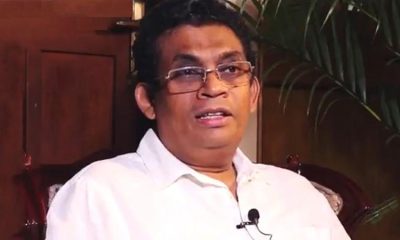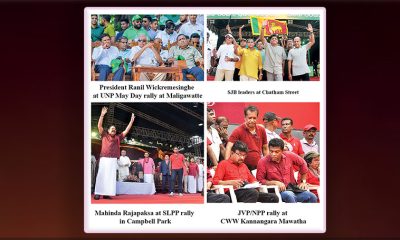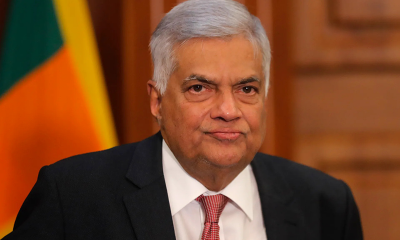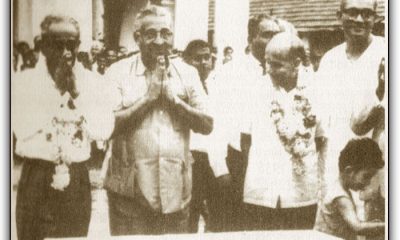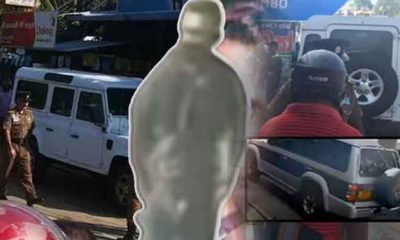Features
President Premadasa’s ascendancy from small beginnings
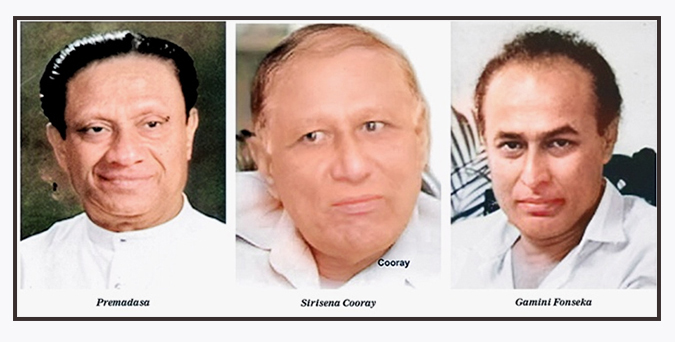
Sirisena Cooray and Gamini Fonseka
(Excerpted from volume ii of Sarath Amunugama autobiograph )
By the time we (the Amunugama family) returned to Colombo President Premadasa had, with characteristic impatience, commitment and sincerity, launched his new programmes for the development of the country. Even as Prime Minister he had no hesitation in offering the voters a new people friendly administration. As his closest confidante Sirisena Cooray has written, that the new Presidents constant admonition to him was “do not forget the people”.
Before he came on the scene Colombo Central – the largest electorate in the island with three representatives in Parliament – was the playground of the rich Colombo UNP Muslims who were liberal spenders at the time of elections. They were close personal friends of Dudley Senanayake and J.R. Jayewardene. Colombo Central was the closest to what sociologists like Robert Merton have described as urban voting machines.
Politics was enmeshed with obligations of voters who had benefited from the services of ‘ward bosses’ who were agents of the political leaders who represented the electorate. These ward bosses were friends of the poor and the helpless majority of voters who needed a `powerful friend’ to help them navigate their lives in a social context which necessitated constant interaction with various authorities who wielded power from the municipality upwards.
Tambiah in his groundbreaking sociological study of `Wattas’ [Compounds] in Colombo municipal areas around Maradana has highlighted these intermeshing obligations which tend to transform themselves into votes for their ward bosses ‘patrons’ at election time. The Marxist left too tended to duplicate this pattern of ward representatives who would deliver votes to their party candidate at an election.
These ward bosses, as in the case of Chicago studied by Merton, were selected on particularistic criteria to suit the ethnic composition of the locality they served. Thus even Marxists would ensure that the ward leader of a particular area would emerge from the largest caste concentrated in that locality. Fortunately for the Marxists their top leaders were drawn from all the leading castes in the country and they could, perhaps unwittingly, corral their caste and party comrades.
Premadasa as a son of the urban poor, had an unparalleled knowledge of Colombo’s electoral mathematics. But he, coming from a numerically small caste, could create a support base which included the poor of all large castes who were mesmerized by his superb oratory which attacked all high and mighty oppressors and spoke up for the underprivileged and dispossessed. His speeches had an authenticity which could not be matched by the westernized politicians of every persuasion.
As described in volume one of my autobiography I owed the trajectory of my public service career to Premadasa who plucked me out of a large number of colleagues with the same seniority to head the Department of Information at a comparatively young age in 1967. He was then the Deputy Minister of Information and chafing under the reluctance of Dudley Senanayake to give him a cabinet position though he was the chief speaker for the UNP in the 1965 general election.
It was only in 1968 that he entered the Cabinet on the resignation of his Minister Tiruchelvam. So I was well aware of the heroic struggle he had to engage in to enter the higher rungs of his party. That unfair social prejudice remained even up to the day of his untimely and violent death. I knew that his cry of a few days before when he said, “kill me but do not tarnish my character” was a heartfelt one. Since he was sensitive to social prejudice against him Premadasa created a coterie of loyalists who were both efficient and sympathetic to change. He was a hard taskmaster but he also gave credit to his staff who implemented his orders without question.
His Chief of Staff was Sirisena Cooray whose family had been involved in municipal politics of the UNP for generations and were early supporters of Premadasa. In fact Premadasa was not a born ‘true green’ UNPer. His early political affiliation was with the Labour Party of A.E. Goonesinha who led the Colombo working class before the foreign trained Marxists displaced him. Premadasa’s father Richard came from the same village as Goonesinha in Balapitiya. Inspired and aided by his fellow villager Goonesinha Richard set up a transport business in the vicinity of the Colombo harbour which was the strong hold of the Labour leader.
I was told by Premadasa that his father managed hackeries used to transport people and goods a business that flourished during the growth of Colombo city. He followed his mentor Goonesinha into Labour party politics and contested a seat in the municipality. He was defeated in his first foray and when Goonesinha, increasingly under pressure from the Marxists, allied himself with the UNP young Premadasa, whose political talents were recognized by the local populace, also joined the UNP and was elected to the Council from a UNP ‘pocket borough’.
From then on despite many obstacles Premadasa never looked back. Many of the old stagers of the UNP led by V.A. Sugathadasa opposed him but he prevailed. This was due to two factors; his superb speaking skills and organizing ability. Premadasa was easily one of the best speakers on the UNP platform. He was a brilliant, attacking speaker and the UNP pitted him against Bandaranaike who too was a brilliant orator but without the Sinhala language skills of the young ‘nationalist’ challenger from San Sabastian Hill.
Premadasa’s organizational skills were legendary. He undertook responsibilities that other party members shirked. For instance he contested the Ruwanwella seat which was held by N.M. Perera at the request of the party. He told me that he went to Ruwanwella for the first time to hand over his nomination papers. Nevertheless his electoral organization was so efficient that he gave a good fight to the LSSP leader. After the election NM, in his usual generous manner, had complimented Premadasa for a splendid effort.
He had great respect for the LSSP leaders especially NM and Colvin and did not attack them with the venom he reserved for Bandaranaike. Later when he was my ‘boss’ as deputy Minister of Information I found that Premadasa never forgot his supporters from Ruwanwella. He helped them even though he had by then established himself in Colombo Central and had no intention of going back to the “Four Korales”.
Sirisena Cooray, whose brother Nandisena was a senior UNP municipal councillor and early mentor of Premadasa, was the `Alter Ego’ of the young politician and the two of them became a formidable force in municipal and later, national politics. It was not easy to deny Premadasa his wishes when he set his mind to it. When I was Secretary to the Ministry of Tourism I refused to grant a gaming license to a Chinese businessman who had become a friend of Premadasa as instructed by JRJ who was afraid of starting another confrontation with the Buddhist monks who were advocates of Temperence.
Premadasa ignored JRJs instructions and got Cooray who was the Mayor of Colombo to issue the businessmen a gaming license under Municipal Council bye-laws. JRJ turned a blind eye to this insult but soon Premadasa himself fell out with the Chinese businessman and had him bundled out of the country within 48 hours and JRJ and my Minister Anandatissa de Alwis had the last laugh.
Sweeping Changes
The new President made sweeping changes. On the Economic Front he introduced the garment industry. This drew in foreign investment throughout the country in addition to providing employment to thousands of rural women. It also had a spin off effect on other services for the nascent industry. In his own colorful phraseology he had enabled the poor rural girl to earn an income and buy her own gold necklace. This was an opportune time because other manufacturers had exhausted their preferential quotas and were willing to transfer some of their production centres to Sri Lanka.
He encouraged the migration of workers to the Middle East, thereby opening up a new source of foreign exchange and employment which even today is an important prop of our economy. On the welfare front he launched the Jana Saviya programme which created a safety net for those below the poverty line. His trademark housing programme caught the imagination of the poor and the homeless.
Perhaps remembering our national exhibitions of Dudley Senanayake’s time when he was my deputy minister at the time I was Director of Information’ he began district level exhibitions which also catered to fun and frolic called `Gam Udawa’. Keeping to his election pledge he managed to get the Government of V.P. Singh to withdraw the IPKF in short order. He failed in his overtures to the JVP and the LTTE even though he was willing to compromise in order to open a new path to peace and reconciliation.
But he failed due to the intransigence of both terror groups. Rukman Senanayake became his trusted intermediary to the JVP in discussions held in ‘Woodlands’. But the JVP was too fragmented for quick decision making as they were on the run from the armed services which were wresting the initiative from them. Moreover, secret communications of the JVP were distrusted by the armed services which were better organized now under the management of Ranjan Wijeratne and were confident of victory.
When talks failed Ranjan launched an all-out offensive which saw brutal killings by both sides. Finally, the JVP leadership were all eliminated, and the uprising came to an end. Among those killed was Richard de Zoysa who is alleged to have supported the JVP. I remembered the time when Richard and I had office rooms in the same compound at Kinross Avenue, as I have mentioned before. He was the local correspondent of IPS and I was the Additional Secretary General of WIF.
We were all shocked by his murder and I recall the small knot of people at Kanatte cemetery on a gloomy evening when we said farewell to him. Close friends published a paid supplement in the newspapers in his memory and I had no hesitation in writing about him and our friendship, though several of his close friends were afraid to contribute because they knew that the Premadasa regime had killed him. The tragedy was that Richard had been warned of impending danger and was to leave Colombo for IPS headquarters in Rome in a few days en route for an European assignment.
Gamini Fonseka
With the ascent of Premadasa to the Presidential ‘gadi’ two of my close friends Gamini Fonseka and Indra de Silva became part of his inner circle. Indra worked in the information section of the USIS when Premadasa was a junior minister of information in the Dudley Senanayake government. He helped to bring the ambitious neophyte deputy into the ‘patrons list’ of the embassy and arrange to send him on a trip t the US under an exchange programme. Indra had taken early retirement and as customary been granted a pension and US citizenship. He settled down in Washington and was much sought after by the State Department particularly to escort visiting Sri Lankan dignitaries. He also kept in touch with many of the US foreign service officers who had served in Colombo.
President…
The new President immediately appointed Indra to our mission in Washington and made him his “eyes and ears” there, much to the embarrassment of our Foreign Service officials serving in Washington who had been up to then a law unto themselves. He also moved house from his earlier dingy quarters to the famous, or notorious, Watergate apartments located in a posh area in Washington which was in close proximity to the Potomac river and the Kennedy Centre.
Later he relocated to Colombo at the Presidents request but was left stranded after his assassination. Indra died not long after. My other friend was Gamini Fonseka who was a buddy of Premadasa during good times and bad. When in the opposition he set up his “Citizens Front” [Purawesi Peramuna] Gamini was a prominent speaker on its platform together with other favourites like Tilak Ratnakara. However with the death of Dudley, Premadasa teamed up with JRJ and disbanded his `Peramuna’.
As President he quickly brought Gamini to Parliament from Matara electorate, which was a Durawe stronghold, and made him the Deputy Speaker. He was eminently qualified for this position as he was a fluent trilingual speaker. He also won the confidence of the Tamil MPs who knew that Gamini had risked much in denouncing Sinhala communalism of that time. The tradition then was to appoint a trilingual MP as Speaker and his Deputy. Unfortunately that salutary tradition, like many others, has now been breached and party loyalty rather than competence seems to have won the day.
I suspected that Gamini would have preferred to be a Minister. Relations had cooled between the two when the President was assassinated. After that my friend retired from politics and concentrated on his film career thereby delivering some superb screen performances. He was a chain smoker and in characteristic braggadacio ignored all medical advice. He was asked to undergo heart surgery by his doctors but he ignored their advice and died in his sleep. By this time Premadasa was long gone and I am glad to record their friendship which was a part of our history associated with the rise and sudden fall of an unforgettable character who dominated politics in his time just as Gamini dominated the Sinhala screen for those several decades.
Features
The heart-friendly health minister

by Dr Gotabhya Ranasinghe
Senior Consultant Cardiologist
National Hospital Sri Lanka
When we sought a meeting with Hon Dr. Ramesh Pathirana, Minister of Health, he graciously cleared his busy schedule to accommodate us. Renowned for his attentive listening and deep understanding, Minister Pathirana is dedicated to advancing the health sector. His openness and transparency exemplify the qualities of an exemplary politician and minister.
Dr. Palitha Mahipala, the current Health Secretary, demonstrates both commendable enthusiasm and unwavering support. This combination of attributes makes him a highly compatible colleague for the esteemed Minister of Health.
Our discussion centered on a project that has been in the works for the past 30 years, one that no other minister had managed to advance.
Minister Pathirana, however, recognized the project’s significance and its potential to revolutionize care for heart patients.
The project involves the construction of a state-of-the-art facility at the premises of the National Hospital Colombo. The project’s location within the premises of the National Hospital underscores its importance and relevance to the healthcare infrastructure of the nation.
This facility will include a cardiology building and a tertiary care center, equipped with the latest technology to handle and treat all types of heart-related conditions and surgeries.
Securing funding was a major milestone for this initiative. Minister Pathirana successfully obtained approval for a $40 billion loan from the Asian Development Bank. With the funding in place, the foundation stone is scheduled to be laid in September this year, and construction will begin in January 2025.
This project guarantees a consistent and uninterrupted supply of stents and related medications for heart patients. As a result, patients will have timely access to essential medical supplies during their treatment and recovery. By securing these critical resources, the project aims to enhance patient outcomes, minimize treatment delays, and maintain the highest standards of cardiac care.
Upon its fruition, this monumental building will serve as a beacon of hope and healing, symbolizing the unwavering dedication to improving patient outcomes and fostering a healthier society.We anticipate a future marked by significant progress and positive outcomes in Sri Lanka’s cardiovascular treatment landscape within the foreseeable timeframe.
Features
A LOVING TRIBUTE TO JESUIT FR. ALOYSIUS PIERIS ON HIS 90th BIRTHDAY

by Fr. Emmanuel Fernando, OMI
Jesuit Fr. Aloysius Pieris (affectionately called Fr. Aloy) celebrated his 90th birthday on April 9, 2024 and I, as the editor of our Oblate Journal, THE MISSIONARY OBLATE had gone to press by that time. Immediately I decided to publish an article, appreciating the untiring selfless services he continues to offer for inter-Faith dialogue, the renewal of the Catholic Church, his concern for the poor and the suffering Sri Lankan masses and to me, the present writer.
It was in 1988, when I was appointed Director of the Oblate Scholastics at Ampitiya by the then Oblate Provincial Fr. Anselm Silva, that I came to know Fr. Aloy more closely. Knowing well his expertise in matters spiritual, theological, Indological and pastoral, and with the collaborative spirit of my companion-formators, our Oblate Scholastics were sent to Tulana, the Research and Encounter Centre, Kelaniya, of which he is the Founder-Director, for ‘exposure-programmes’ on matters spiritual, biblical, theological and pastoral. Some of these dimensions according to my view and that of my companion-formators, were not available at the National Seminary, Ampitiya.
Ever since that time, our Oblate formators/ accompaniers at the Oblate Scholasticate, Ampitiya , have continued to send our Oblate Scholastics to Tulana Centre for deepening their insights and convictions regarding matters needed to serve the people in today’s context. Fr. Aloy also had tried very enthusiastically with the Oblate team headed by Frs. Oswald Firth and Clement Waidyasekara to begin a Theologate, directed by the Religious Congregations in Sri Lanka, for the contextual formation/ accompaniment of their members. It should very well be a desired goal of the Leaders / Provincials of the Religious Congregations.
Besides being a formator/accompanier at the Oblate Scholasticate, I was entrusted also with the task of editing and publishing our Oblate journal, ‘The Missionary Oblate’. To maintain the quality of the journal I continue to depend on Fr. Aloy for his thought-provoking and stimulating articles on Biblical Spirituality, Biblical Theology and Ecclesiology. I am very grateful to him for his generous assistance. Of late, his writings on renewal of the Church, initiated by Pope St. John XX111 and continued by Pope Francis through the Synodal path, published in our Oblate journal, enable our readers to focus their attention also on the needed renewal in the Catholic Church in Sri Lanka. Fr. Aloy appreciated very much the Synodal path adopted by the Jesuit Pope Francis for the renewal of the Church, rooted very much on prayerful discernment. In my Religious and presbyteral life, Fr.Aloy continues to be my spiritual animator / guide and ongoing formator / acccompanier.
Fr. Aloysius Pieris, BA Hons (Lond), LPh (SHC, India), STL (PFT, Naples), PhD (SLU/VC), ThD (Tilburg), D.Ltt (KU), has been one of the eminent Asian theologians well recognized internationally and one who has lectured and held visiting chairs in many universities both in the West and in the East. Many members of Religious Congregations from Asian countries have benefited from his lectures and guidance in the East Asian Pastoral Institute (EAPI) in Manila, Philippines. He had been a Theologian consulted by the Federation of Asian Bishops’ Conferences for many years. During his professorship at the Gregorian University in Rome, he was called to be a member of a special group of advisers on other religions consulted by Pope Paul VI.
Fr. Aloy is the author of more than 30 books and well over 500 Research Papers. Some of his books and articles have been translated and published in several countries. Among those books, one can find the following: 1) The Genesis of an Asian Theology of Liberation (An Autobiographical Excursus on the Art of Theologising in Asia, 2) An Asian Theology of Liberation, 3) Providential Timeliness of Vatican 11 (a long-overdue halt to a scandalous millennium, 4) Give Vatican 11 a chance, 5) Leadership in the Church, 6) Relishing our faith in working for justice (Themes for study and discussion), 7) A Message meant mainly, not exclusively for Jesuits (Background information necessary for helping Francis renew the Church), 8) Lent in Lanka (Reflections and Resolutions, 9) Love meets wisdom (A Christian Experience of Buddhism, 10) Fire and Water 11) God’s Reign for God’s poor, 12) Our Unhiddden Agenda (How we Jesuits work, pray and form our men). He is also the Editor of two journals, Vagdevi, Journal of Religious Reflection and Dialogue, New Series.
Fr. Aloy has a BA in Pali and Sanskrit from the University of London and a Ph.D in Buddhist Philosophy from the University of Sri Lankan, Vidyodaya Campus. On Nov. 23, 2019, he was awarded the prestigious honorary Doctorate of Literature (D.Litt) by the Chancellor of the University of Kelaniya, the Most Venerable Welamitiyawe Dharmakirthi Sri Kusala Dhamma Thera.
Fr. Aloy continues to be a promoter of Gospel values and virtues. Justice as a constitutive dimension of love and social concern for the downtrodden masses are very much noted in his life and work. He had very much appreciated the commitment of the late Fr. Joseph (Joe) Fernando, the National Director of the Social and Economic Centre (SEDEC) for the poor.
In Sri Lanka, a few religious Congregations – the Good Shepherd Sisters, the Christian Brothers, the Marist Brothers and the Oblates – have invited him to animate their members especially during their Provincial Congresses, Chapters and International Conferences. The mainline Christian Churches also have sought his advice and followed his seminars. I, for one, regret very much, that the Sri Lankan authorities of the Catholic Church –today’s Hierarchy—- have not sought Fr.
Aloy’s expertise for the renewal of the Catholic Church in Sri Lanka and thus have not benefited from the immense store of wisdom and insight that he can offer to our local Church while the Sri Lankan bishops who governed the Catholic church in the immediate aftermath of the Second Vatican Council (Edmund Fernando OMI, Anthony de Saram, Leo Nanayakkara OSB, Frank Marcus Fernando, Paul Perera,) visited him and consulted him on many matters. Among the Tamil Bishops, Bishop Rayappu Joseph was keeping close contact with him and Bishop J. Deogupillai hosted him and his team visiting him after the horrible Black July massacre of Tamils.
Features
A fairy tale, success or debacle

Sri Lanka-Singapore Free Trade Agreement
By Gomi Senadhira
senadhiragomi@gmail.com
“You might tell fairy tales, but the progress of a country cannot be achieved through such narratives. A country cannot be developed by making false promises. The country moved backward because of the electoral promises made by political parties throughout time. We have witnessed that the ultimate result of this is the country becoming bankrupt. Unfortunately, many segments of the population have not come to realize this yet.” – President Ranil Wickremesinghe, 2024 Budget speech
Any Sri Lankan would agree with the above words of President Wickremesinghe on the false promises our politicians and officials make and the fairy tales they narrate which bankrupted this country. So, to understand this, let’s look at one such fairy tale with lots of false promises; Ranil Wickremesinghe’s greatest achievement in the area of international trade and investment promotion during the Yahapalana period, Sri Lanka-Singapore Free Trade Agreement (SLSFTA).
It is appropriate and timely to do it now as Finance Minister Wickremesinghe has just presented to parliament a bill on the National Policy on Economic Transformation which includes the establishment of an Office for International Trade and the Sri Lanka Institute of Economics and International Trade.
Was SLSFTA a “Cleverly negotiated Free Trade Agreement” as stated by the (former) Minister of Development Strategies and International Trade Malik Samarawickrama during the Parliamentary Debate on the SLSFTA in July 2018, or a colossal blunder covered up with lies, false promises, and fairy tales? After SLSFTA was signed there were a number of fairy tales published on this agreement by the Ministry of Development Strategies and International, Institute of Policy Studies, and others.
However, for this article, I would like to limit my comments to the speech by Minister Samarawickrama during the Parliamentary Debate, and the two most important areas in the agreement which were covered up with lies, fairy tales, and false promises, namely: revenue loss for Sri Lanka and Investment from Singapore. On the other important area, “Waste products dumping” I do not want to comment here as I have written extensively on the issue.
1. The revenue loss
During the Parliamentary Debate in July 2018, Minister Samarawickrama stated “…. let me reiterate that this FTA with Singapore has been very cleverly negotiated by us…. The liberalisation programme under this FTA has been carefully designed to have the least impact on domestic industry and revenue collection. We have included all revenue sensitive items in the negative list of items which will not be subject to removal of tariff. Therefore, 97.8% revenue from Customs duty is protected. Our tariff liberalisation will take place over a period of 12-15 years! In fact, the revenue earned through tariffs on goods imported from Singapore last year was Rs. 35 billion.
The revenue loss for over the next 15 years due to the FTA is only Rs. 733 million– which when annualised, on average, is just Rs. 51 million. That is just 0.14% per year! So anyone who claims the Singapore FTA causes revenue loss to the Government cannot do basic arithmetic! Mr. Speaker, in conclusion, I call on my fellow members of this House – don’t mislead the public with baseless criticism that is not grounded in facts. Don’t look at petty politics and use these issues for your own political survival.”
I was surprised to read the minister’s speech because an article published in January 2018 in “The Straits Times“, based on information released by the Singaporean Negotiators stated, “…. With the FTA, tariff savings for Singapore exports are estimated to hit $10 million annually“.
As the annual tariff savings (that is the revenue loss for Sri Lanka) calculated by the Singaporean Negotiators, Singaporean $ 10 million (Sri Lankan rupees 1,200 million in 2018) was way above the rupees’ 733 million revenue loss for 15 years estimated by the Sri Lankan negotiators, it was clear to any observer that one of the parties to the agreement had not done the basic arithmetic!
Six years later, according to a report published by “The Morning” newspaper, speaking at the Committee on Public Finance (COPF) on 7th May 2024, Mr Samarawickrama’s chief trade negotiator K.J. Weerasinghehad had admitted “…. that forecasted revenue loss for the Government of Sri Lanka through the Singapore FTA is Rs. 450 million in 2023 and Rs. 1.3 billion in 2024.”
If these numbers are correct, as tariff liberalisation under the SLSFTA has just started, we will pass Rs 2 billion very soon. Then, the question is how Sri Lanka’s trade negotiators made such a colossal blunder. Didn’t they do their basic arithmetic? If they didn’t know how to do basic arithmetic they should have at least done their basic readings. For example, the headline of the article published in The Straits Times in January 2018 was “Singapore, Sri Lanka sign FTA, annual savings of $10m expected”.
Anyway, as Sri Lanka’s chief negotiator reiterated at the COPF meeting that “…. since 99% of the tariffs in Singapore have zero rates of duty, Sri Lanka has agreed on 80% tariff liberalisation over a period of 15 years while expecting Singapore investments to address the imbalance in trade,” let’s turn towards investment.
Investment from Singapore
In July 2018, speaking during the Parliamentary Debate on the FTA this is what Minister Malik Samarawickrama stated on investment from Singapore, “Already, thanks to this FTA, in just the past two-and-a-half months since the agreement came into effect we have received a proposal from Singapore for investment amounting to $ 14.8 billion in an oil refinery for export of petroleum products. In addition, we have proposals for a steel manufacturing plant for exports ($ 1 billion investment), flour milling plant ($ 50 million), sugar refinery ($ 200 million). This adds up to more than $ 16.05 billion in the pipeline on these projects alone.
And all of these projects will create thousands of more jobs for our people. In principle approval has already been granted by the BOI and the investors are awaiting the release of land the environmental approvals to commence the project.
I request the Opposition and those with vested interests to change their narrow-minded thinking and join us to develop our country. We must always look at what is best for the whole community, not just the few who may oppose. We owe it to our people to courageously take decisions that will change their lives for the better.”
According to the media report I quoted earlier, speaking at the Committee on Public Finance (COPF) Chief Negotiator Weerasinghe has admitted that Sri Lanka was not happy with overall Singapore investments that have come in the past few years in return for the trade liberalisation under the Singapore-Sri Lanka Free Trade Agreement. He has added that between 2021 and 2023 the total investment from Singapore had been around $162 million!
What happened to those projects worth $16 billion negotiated, thanks to the SLSFTA, in just the two-and-a-half months after the agreement came into effect and approved by the BOI? I do not know about the steel manufacturing plant for exports ($ 1 billion investment), flour milling plant ($ 50 million) and sugar refinery ($ 200 million).
However, story of the multibillion-dollar investment in the Petroleum Refinery unfolded in a manner that would qualify it as the best fairy tale with false promises presented by our politicians and the officials, prior to 2019 elections.
Though many Sri Lankans got to know, through the media which repeatedly highlighted a plethora of issues surrounding the project and the questionable credentials of the Singaporean investor, the construction work on the Mirrijiwela Oil Refinery along with the cement factory began on the24th of March 2019 with a bang and Minister Ranil Wickremesinghe and his ministers along with the foreign and local dignitaries laid the foundation stones.
That was few months before the 2019 Presidential elections. Inaugurating the construction work Prime Minister Ranil Wickremesinghe said the projects will create thousands of job opportunities in the area and surrounding districts.
The oil refinery, which was to be built over 200 acres of land, with the capacity to refine 200,000 barrels of crude oil per day, was to generate US$7 billion of exports and create 1,500 direct and 3,000 indirect jobs. The construction of the refinery was to be completed in 44 months. Four years later, in August 2023 the Cabinet of Ministers approved the proposal presented by President Ranil Wickremesinghe to cancel the agreement with the investors of the refinery as the project has not been implemented! Can they explain to the country how much money was wasted to produce that fairy tale?
It is obvious that the President, ministers, and officials had made huge blunders and had deliberately misled the public and the parliament on the revenue loss and potential investment from SLSFTA with fairy tales and false promises.
As the president himself said, a country cannot be developed by making false promises or with fairy tales and these false promises and fairy tales had bankrupted the country. “Unfortunately, many segments of the population have not come to realize this yet”.
(The writer, a specialist and an activist on trade and development issues . )


